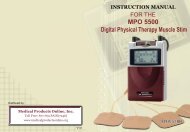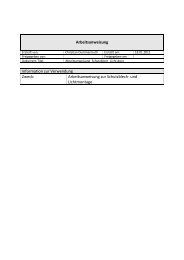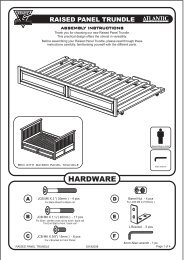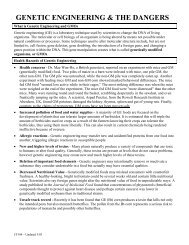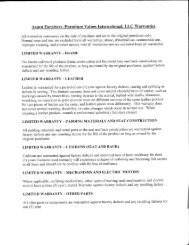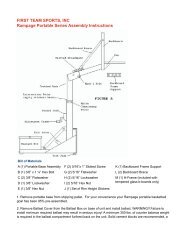New SunWize Grid-Tie Systems
New SunWize Grid-Tie Systems
New SunWize Grid-Tie Systems
You also want an ePaper? Increase the reach of your titles
YUMPU automatically turns print PDFs into web optimized ePapers that Google loves.
Addendum: Best Practices<br />
Addendum<br />
Steps-To-Success Commercial Installation<br />
Introduction<br />
While the steps involved in residential and commercial PV installation are virtually identical, what transpires within each step is significantly<br />
different. Residential and commercial installations are like apples and oranges, but both require disciplined progression through a<br />
progress where steps must be followed in sequence and not short-cut or skipped. This document examines each step in more detail for<br />
commercial installations, highlighting common pitfalls as well as proven practices. It is intended as a companion and contrast to Stepsto-Success:<br />
Residential Installation.<br />
Lead Generation<br />
Like its residential counterpart, the key to success in a commercial solar installation<br />
business is to have a steady volume of incoming leads. However, generation of commercial<br />
leads is completely different than residential. Commercial leads come from<br />
direct solicitation of businesses, responding to public RFPs (Requests for Proposals),<br />
and through third parties such as PPA (Power Purchase Agreement) providers.<br />
Common Pitfall: Many installers do not sufficiently focus their efforts into opportunities<br />
where they have the experience and competencies to be successful. Partnering<br />
with experienced commercial installers on projects is one way to avoid this pitfall.<br />
Proven Practice: Successful commercial installers target specify groups of customers<br />
through vertical marketing (e.g. wineries, national retailers, storage companies,<br />
education, government agencies).<br />
Lead Qualification<br />
Once a commercial opportunity comes in, it needs to be carefully evaluated using a<br />
different set of criteria than that used for residential homeowners. Installers examine<br />
factors such as project size, location, customer credit worthiness, competition,<br />
performance warranty requirements, need for partners, and technology. The most<br />
important factor is the potential financial return, as virtually all commercial systems are sold on the basis of their economic merits.<br />
Common Pitfall: Pursuing a commercial opportunity requires a significant investment of resources. A common mistake is not obtaining<br />
the previous 12 months of utility bills to analyze the financial return and determine upfront whether it is sufficiently attractive.<br />
Proven Practice: Residential installers successfully expanding into commercial installations begin with small commercial projects in the<br />
10 to 50 kW range and work up from there.<br />
Site Evaluation<br />
Each commercial roof is different, with many considerations. Unlike residential, shade analysis is seldom needed, structural analysis is<br />
a requisite, and the electrical service often requires upgrading. Commercial projects out to bid typically have a formal walk-through that<br />
includes all bidders.<br />
Common Pitfall: Inexperienced installers often fail to pay adequate attention to the roof and its warranty.<br />
Proven Practice: An effective way not to void the roof warranty is to contact the contractor who installed the roof and have them specify<br />
and install any flashings and waterproofing. Non-penetrating racking solutions may also help.<br />
Customer Proposal<br />
Commercial proposals contain sophisticated financial analysis and are at the heart of a long and complex sale. Commercial proposals<br />
undergo frequent revisions taking anywhere from 6-12+ months, including preliminary designs and technology selection. In addition, the<br />
sales cycle is measured in months and often exceeds a year in duration. Instead of a homeowner, the proposal has to be sold to multiple<br />
stakeholders, including owners/top management, CFOs/controllers, operations and facilities managers.<br />
Common Pitfall: Many installers do not develop the financial expertise to understand the more complex commercial rates structures, tax<br />
accounting, and the advanced financial modeling focused on return on investment, internal rates of return, net present value, etc.<br />
Proven Practice: Many commercial systems are sold using the “peak shaving” model of financial justification; using solar to eliminate the<br />
most expensive electricity.<br />
Financing<br />
Financing is often the most critical consideration and biggest obstacle in a commercial project. Financial leases are available to companies<br />
who want to own the systems at the end of the lease period. Power Purchase Agreements, where third parties own and operate the<br />
system and sell the electricity at an attractive rate to the business, are the most common form of financing for businesses. Also, Federal<br />
cash grants (30% of the system cost) are now available to businesses that need a cash rebate to help pay for the system or do not have<br />
enough of a tax bill to be able to make use of a tax credit.<br />
Common Pitfall: Most installers underestimate the difficulty in obtaining financing for a large project. Credit markets are currently very<br />
tight and PPA providers and lenders are extremely selective, working only with the lowest risk and highest creditworthy businesses.<br />
continued<br />
144



